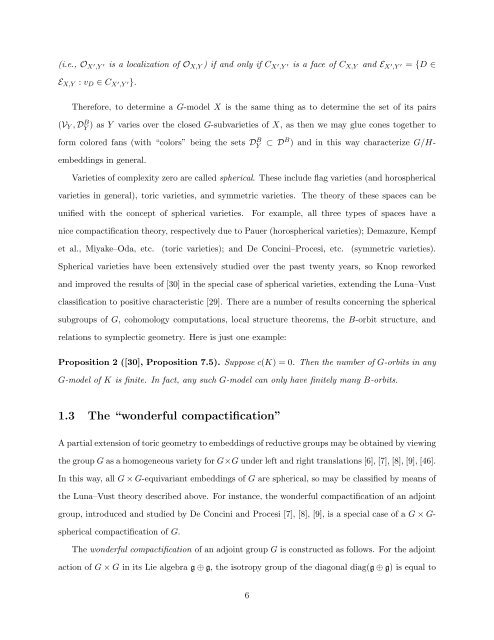Equivariant Embeddings of Algebraic Groups
Equivariant Embeddings of Algebraic Groups
Equivariant Embeddings of Algebraic Groups
Create successful ePaper yourself
Turn your PDF publications into a flip-book with our unique Google optimized e-Paper software.
(i.e., O X ′ ,Y ′ is a localization <strong>of</strong> O X,Y ) if and only if C X ′ ,Y ′ is a face <strong>of</strong> C X,Y and E X ′ ,Y ′ = {D ∈<br />
E X,Y : v D ∈ C X ′ ,Y ′}.<br />
Therefore, to determine a G-model X is the same thing as to determine the set <strong>of</strong> its pairs<br />
(V Y , DY B ) as Y varies over the closed G-subvarieties <strong>of</strong> X, as then we may glue cones together to<br />
form colored fans (with “colors” being the sets D B Y<br />
⊂ DB ) and in this way characterize G/Hembeddings<br />
in general.<br />
Varieties <strong>of</strong> complexity zero are called spherical. These include flag varieties (and horospherical<br />
varieties in general), toric varieties, and symmetric varieties. The theory <strong>of</strong> these spaces can be<br />
unified with the concept <strong>of</strong> spherical varieties.<br />
For example, all three types <strong>of</strong> spaces have a<br />
nice compactification theory, respectively due to Pauer (horospherical varieties); Demazure, Kempf<br />
et al., Miyake–Oda, etc. (toric varieties); and De Concini–Procesi, etc. (symmetric varieties).<br />
Spherical varieties have been extensively studied over the past twenty years, so Knop reworked<br />
and improved the results <strong>of</strong> [30] in the special case <strong>of</strong> spherical varieties, extending the Luna–Vust<br />
classification to positive characteristic [29]. There are a number <strong>of</strong> results concerning the spherical<br />
subgroups <strong>of</strong> G, cohomology computations, local structure theorems, the B-orbit structure, and<br />
relations to symplectic geometry. Here is just one example:<br />
Proposition 2 ([30], Proposition 7.5). Suppose c(K) = 0. Then the number <strong>of</strong> G-orbits in any<br />
G-model <strong>of</strong> K is finite. In fact, any such G-model can only have finitely many B-orbits.<br />
1.3 The “wonderful compactification”<br />
A partial extension <strong>of</strong> toric geometry to embeddings <strong>of</strong> reductive groups may be obtained by viewing<br />
the group G as a homogeneous variety for G×G under left and right translations [6], [7], [8], [9], [46].<br />
In this way, all G × G-equivariant embeddings <strong>of</strong> G are spherical, so may be classified by means <strong>of</strong><br />
the Luna–Vust theory described above. For instance, the wonderful compactification <strong>of</strong> an adjoint<br />
group, introduced and studied by De Concini and Procesi [7], [8], [9], is a special case <strong>of</strong> a G × G-<br />
spherical compactification <strong>of</strong> G.<br />
The wonderful compactification <strong>of</strong> an adjoint group G is constructed as follows. For the adjoint<br />
action <strong>of</strong> G × G in its Lie algebra g ⊕ g, the isotropy group <strong>of</strong> the diagonal diag(g ⊕ g) is equal to<br />
6
















